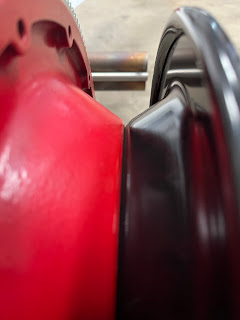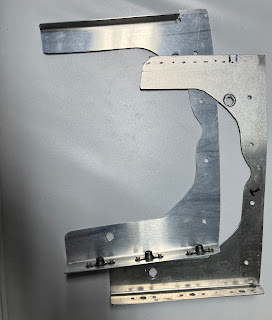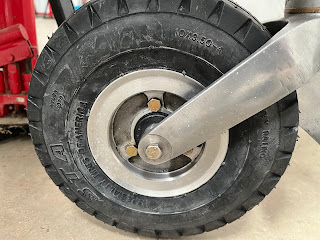Here's the link to the formation clinic info which has additional links to the FFI's documentation:
https://docs.google.com/document/u/0/d/e/2PACX-1vS4PqgR6T6EDhVn6Ybw7pfy3E_5cjjrhk3YWHT1J5P6BFwHLQ3Cm6DaFf0BlyWe3-jwHy8GlLl9Q0G_/pub?mibextid=S66gvF&pli=1
 |
|
Jay Van Every out of Cleburn (CPT) had the opportunity to put some hours on a friend's LEZ so he met me enroute to Ellington (EFD) where the formation clinic was being held. We planned our arrival for 10:30. Jay practiced station keeping, crossing under and trail while I led. Jay was having some avionics issues so was relying on me to navigate and communicate. We went direct to Cleveland (Northeast of Houston) and dropped under the Class B shelf, then South. About 25 miles from Ellington I radioed the CT we were an inbound flight of two and position from the nearest airport. They assigned a squawk code and asked for my location from Ellington which was now about 20 miles NE. They identified us and confirmed only the lead should squawk. About ten miles out, another voice from the tower assigned a new code and advised to report several miles down wind for 17L. Then as we were nearing closer, a third new voice f rom the tower advised to fly direct to the end of 17L and she'd call our base. Before we reached the end of the runway, she advised "when able, turn base". I reduced power, lowered the gear and did an OSH type landing on the 9000' runway with Jay. We managed to find taxiway Kilo despite it not being marked, taxied to the museum and saw some canards parked already. When we shut down, Jay said, "THAT LANDING WAS AWESOME!"
 |
| Jay & me on the way to KEFD. |
Not long after we had parked, Troy Chaddon from Oklahoma taxied a LongEZ in.
We met Jerry Scott with the museum, Richard Sessions the event coordinator, volunteers (Darlene & Jordan) as well as Scott, a Cozy III builder.
Ryzard Zadow had acquired help from some very experienced folks with a variety of aircraft and planned a four ship demonstration with us newbies riding along to get a picture of what we're striving to achieve. A LongEZ was lead, with a T-18 as #2, T-34 and RV7 as #3 & #4. I got to ride in "Bloke's" T-18 Thorpe which was awesome because I'd entertained buying one to fly while I was building. I was briefly given the stick but tended to overcontrol and started oscillating the pitch. Yep. I'm a newbie.
We debriefed, had lunch and then briefed on doing two ship flights with the ships from the 4 ship flight being lead and carrying observers. We completed several two ship flights Thursday afternoon. On my first flight, Bloke was my safety instructor riding in my plane. On another, Ryz was in the right seat. I think I was doing better at not over controlling the throttle and pitch but was still to conservative and taking to long to rejoin. On the first section take off with the T-18 in the lead, I over modulated the throttle right at about rotation and when the T-18 went airborne, we shot ahead as we quickly gained speed when we went airborne. Ryz called "we were lead" and we coordinated a rejoin. When we briefed for the next flight, Rodney and Bloke agreed a higher RPM on take off for the RV7 would be good. With the previous experience, I did better at matching power this time.
Dynon emailed a bulletin on the Autopilot panel that was classified as a safety of flight issue that showed up in my mail box Thursday evening. Friday morning, I advised Ryz that I needed to check the serial # before flight and fortunately the serial number was in between affected units.
Several of us had trouble hearing the tower and I found that I needed to open the squelch on tower frequency when we were at taxiway B.
On Saturday, Rodney was to be my right seater but the Cozy's fuel pressure was reading 80 PSI, which is double what it usually reads. "This isn't normal...I'm not comfortable taking this on a flight." Rodney agreed and quickly said we'd take his RV instead. Flights continued but Saturday afternoon I opted to pull the cowls and work on my plane. I found a bolt on the large ground cable a smidge loose and one of the positives on the master was a touch loose. I checked the ground terminal strips in the hell hole and engine bay as well. Some of the small ground wires on the pilot side terminal strip needed tightened a tiny bit. Jordan & Richard came over and looked the engine over and took some photos. I taxied over for fuel and saw the Super Guppy doing touch and goes. On a subsequent engine start, the engine was acting like the plugs were really fouled. The cowls came off again a spark plug didn't look bad, but like it had been wet. The plugs are apparently fouling during the richer start cycle. A full power test run seemed to be okay so put the cowls back on and chatted with others about if it was safe to fly home. I was pretty confident after starting, the engine would run fine but I'd need to put new plugs in and tweak the fuel map a bit leaner.
Sunday, Jay & I departed after another formation flight was completed. We reversed our flight path, so flew to Cleveland, then turned to Cleburn with me squawking 1203 and making advisory calls along the route. Jay practiced station keeping, finger tip, cross under and trail positions with our KIAS at about 130 and later a little faster after we'd climbed up to 6500.
We descended to TPA at CPT, did an inspection pass down 15, then right break but I continued North and Jay landed. I switched the squawk code to 1200, called Meachum for transition clearance to Hicks. The pattern wasn't busy with a bit of a x-wind out of the West.
Ryz wanted to know that we'd made it home so I texted Jay first and asked him to text Ryz. I thought Jay may want to let him know that he'd gotten another hour of practice.
It's nice to be home.


























